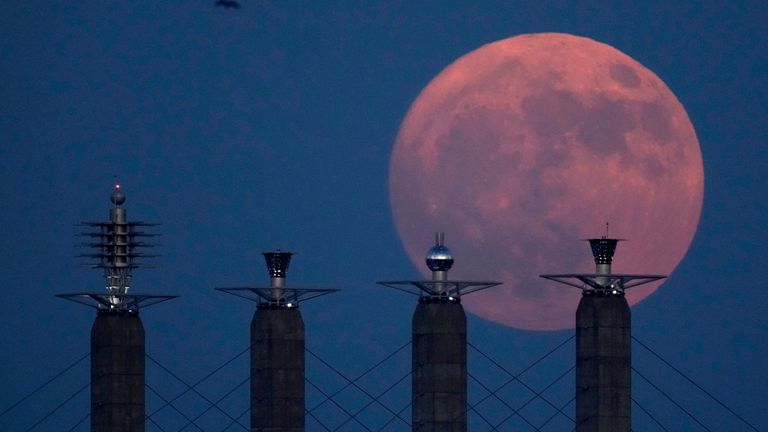Stargazers are getting ready for not one but two supermoons in August – culminating in a rare blue moon.
The supermoon phenomenon takes place when a full moon is near its closest point to Earth, making it appear up to 14% bigger and 30% brighter compared with when it is furthest away.
People will get to see the first on Tuesday evening, 1 August, as the full moon rises in the southeast from a mere 222,159 miles (357,530km) away.
It will be even closer on the night of Wednesday 30 August, at a distance of 222,043 miles (357,344km) – and because it is the second full moon in the same month, it is known as a blue moon.
These figures compare with a distance of about 252,088 miles (405,696km) when the moon is at its furthest point from Earth.
How to see the supermoon

Pic: AP
“Warm summer nights are the ideal time to watch the full moon rise in the eastern sky within minutes of sunset, and it happens twice in August,” said retired NASA astrophysicist Fred Espenak, who is nicknamed Mr Eclipse.
People using binoculars or telescopes may even be able to see features such as lunar maria – the dark plains formed by ancient volcanic lava flows – and rays emanating from lunar craters, Mr Espenak said, provided skies are clear.
“So long as there’s not too much cloud, the full moon will be an unmistakable white orb in the sky,” Royal Museums Greenwich states. “This is a good opportunity to use a small telescope or a pair of binoculars to see the moon’s detailed surface, or even try taking a few interesting moon photos.
“However, you can see the moon perfectly well with just your eyes. Seeing moonrise just after sunset, or moonset just before sunrise, will be an impressive sight as it will appear enormous compared to the surrounding landscape.”
Once in a blue moon
A full moon happens once in each lunar cycle, which lasts 29.5 days. As the moon travels in an elliptical path around, rather than circular, there are times when it is closer than others.
The last time two full supermoons appeared in the same month was in 2018 – and it won’t happen again until 2037, according to Italian astronomer Gianluca Masi, founder of the Virtual Telescope Project – hence the phrase “once in a blue moon”.
Mr Masi will provide a live webcast of Tuesday evening’s supermoon as it rises over the Coliseum in Rome.
“My plans are to capture the beauty of this… hopefully bringing the emotion of the show to our viewers,” he said. “The supermoon offers us a great opportunity to look up and discover the sky.”
Writing on his website, Mr Masi explained why the supermoon appears bigger than usual.
“At night, the full moon is very bright, almost dazzling, compared to the darkness of the landscape, he said. “At its rise, the moon appears behind monuments and elements of the landscape, generating the feeling that its disk is larger than usual, but this is just an optical illusion, due to the presence of those terrestrial elements on the line of sight, giving grounds for comparison.”
According to NASA, Mercury and Mars – which can be visible using only the naked eye – will appear in the sky as the supermoon rises on Tuesday.
Read more: Pictures from the July supermoon

This year’s first supermoon was in July, while the fourth and last will be in September.
The reason for moons being given different names dates back years and relates to the behaviour of the plants, animals, or weather.
According to the Old Farmer’s Almanac, the August full moon is traditionally known as the sturgeon moon – because of the abundance of the fish in North America’s Great Lakes in August, hundreds of years ago.







